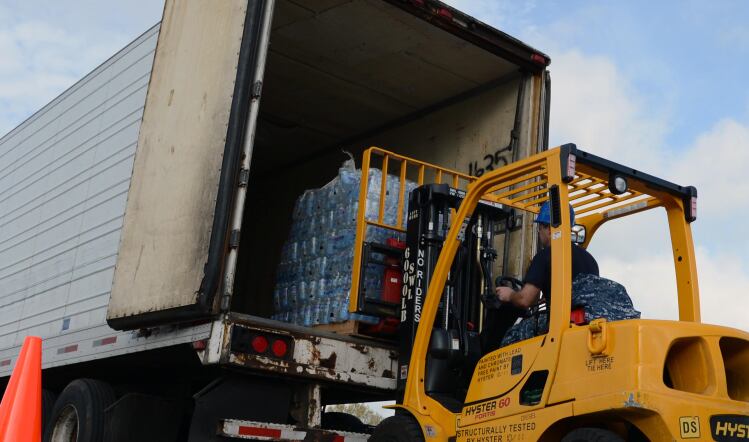The first challenge she addressed was the exposure of products to warm, humid air during docking, loading and unloading.
Many vehicles delivering short life, microbially sensitive products into depots follow trailer manufacturer guidelines and switch off their refrigeration on arrival at their destinations.
Vehicles then pull up about 40ft from the loading bay, drivers open the rear doors and then reverse on to what may or may not be an enclosed, temperature-controlled loading bay.
“The time it takes to complete this process, the ambient temperature and the weather conditions can be extremely varied,” said Dakin. “Once docked a trailer can sit on a bay with the dock doors closed until the operators on the bay are ready to offload.
“Although there is a desire to turn around vehicles quickly, the time frame the vehicle can sit on that bay without the fridge unit on can vary.
“Most cold stores do have policies and protocols in place to control the risks, but by design this scenario represents a break in what should be a continuous cold chain. Hygiene and product temperature can be compromised.”
Thankfully, fears about food shortages linked to Brexit had led to unprecedented growth in UK cold storage capacity, she said. New facilities were being built and older facilities were being renovated.
“Some forward-thinking businesses are building modified docks, so for the first time the doors of a docked vehicle can be opened after the vehicle has fully backed on to the loading bay.”
“This is a standard that I certainly would like to see more of and more businesses asking their cold storage providers to think about this kind of investment. I would also ask why, as an industry, we haven’t called time on unrefrigerated and open-arrival docks.”
Accepted storage temperatures
A second challenge centered on the accepted storage temperatures for frozen food and the idea that keeping products at -18°C was an acceptable standard. Given environmental concerns, Dakin believed that standard could be changed.
“We need to behave more sustainably to protect and preserve our planet. But even the most modern, well-insulated and efficiently operated cold and chill stores use a lot of energy and most of the UK estate is very old and not very efficient.”
She argued relatively little regulation governed frozen food storage. Most legislation was found in quick-frozen food regulations, which applied in the UK, but was under-used.
Other relevant legislation was based on international standards such as the ATP, which is a United Nations agreement on the transport perishable goods.
“Internationally, it is recognised that food is frozen at -12°C. Before the quick frozen food regulations, it was standard practice to transport products at -15°c and even allow for temporary deviations in temperature by 3°C.”
“Where did the -18°C standard come from? It was a temperature of convenience. It was adopted as accepted practice, because it corresponded to 0° Fahrenheit as adopted in the US. It’s fairly arbitrary.”
Dakin explained storage and transportation of foods at -12°C or -15°C did not impact on food safety. But extended storage at these temperatures could affect product quality and shorten ‘Best Before’ life on store shelves.
The decision to use lower temperatures when transporting perishable produce was driven less by food safety concerns and more by retailers demanding food should be on shelf for a long time, she said.
“To put two or three years or even longer on the shelf-life of a frozen food goes way beyond what is necessary for seasonality. I think businesses are quite greedy in terms of the shelf-life they require.”
Dakin called out businesses’ misuse of the cold chain, particularly their use of cold stores and refrigerated trucks to mitigate their poor control or lack of chilling capacity. That consumed more energy as chilled trucks were forced to run at even lower temperatures to compensate, she argued.
“The most energy efficient, food safe and quality preserving method for storage and transport is a constant and consistent cold temperature, even if that temperature is warmer than -18°C. I think -15°C would be a good place to start.
“That would take changes to regulations. The Food Standards Agency recommend -18°C, although it is not necessary for food safety.
“It would take an enormous amount of effort and collaboration to change it, but I do believe that given our environmental challenges, it is a conversation we need to start to have.”
Food security in the cold chain
A third challenge facing the cold chain was the lack of visibility drivers had of load carrying areas and the risk of unauthorised access, said Dakin.
Drivers are responsible for their loads. However, in most cases they had no access to loading bays, so did not see what was loaded on their vehicles, how secure loads were or their condition before starting their journeys, Dakin said.
It could also be hard for drivers to prevent migrants sneaking into the backs of vehicles if they had no access or no way to monitor load-carrying areas, she added.
“Freight distribution is considered one of the most vulnerable aspects of the food supply chain from a security perspective.
“While 360° cameras and GPS systems are becoming more common to monitor the external environment of the vehicle, there is still more that could be done to improve vehicle design and transport security.
“Vehicle seals are very common and some customers make them mandatory, but there are still many journeys where no seal is used.”
Dakin argued a new type of seal could be developed to help protect the security of goods in transit. For example, a padlock could be locked with a randomly generated code, requiring an authenticator to unlock it.
“I can appreciate it is a technical challenge to put cameras inside a frozen or chilled environment. But it must be possible to develop technology to put into the load-carrying area so the driver can see what is going on and avoid some of the issues.”


